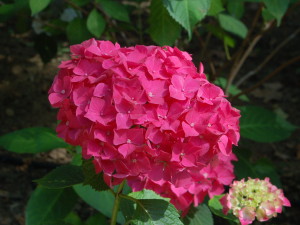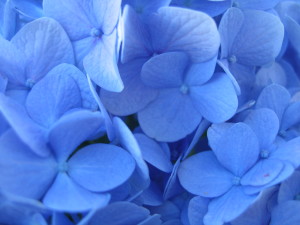You may have heard that you can change the color of a hydrangea’s flowers by adjusting soil pH. But there’s a little more to it than that. First of all, not all hydrangeas produce blue flowers. Hydrangeas with white or cream flowers, such as Annabelle hydrangeas, oakleaf hydrangeas and members of the PeeGee family, can only produce white or cream flowers. Sometimes their blooms take on a pink tinge at the end of the season, but that’s about as colorful as they get.
Hydrangeas with bloom colors that range from pink through blue and purple usually belong to the hydrangea cultivars known as mopheads and lacecaps. These types of hydrangeas have the interesting ability to change the color of their blooms based on the chemistry of the soil. When grown in alkaline soil, the bloom colors are pinker. When grown in acidic soil, the bloom colors are bluer.

 Because soil chemistry determines the bloom color, the variety names given to these types of hydrangeas means very little when it comes to bloom color. For instance, Nikko Blue, Pretty in Pink, Forever Pink and Blue Deckle, all have an almost equal chance of blooming pink or blue, depending on the soil they are planted in. So remember that even if you purchase a hydrangea in bloom, you cannot be sure the plant will produce the same color flowers once it’s growing in your garden.
Because soil chemistry determines the bloom color, the variety names given to these types of hydrangeas means very little when it comes to bloom color. For instance, Nikko Blue, Pretty in Pink, Forever Pink and Blue Deckle, all have an almost equal chance of blooming pink or blue, depending on the soil they are planted in. So remember that even if you purchase a hydrangea in bloom, you cannot be sure the plant will produce the same color flowers once it’s growing in your garden.
To manipulate the color of a hydrangea’s blooms, the soil’s pH level and mineral content need to be changed. In order to maintain growing conditions that result in a specific bloom color, you may need to apply specific soil amendments several times during the growing season To encourage blue hydrangea flowers, grow the plant in soil that has a pH of 5.2-5.5. If your soil is more alkaline, you can lower the pH by applying garden sulphur at the rate specified on the package. Soil pH can also be lowered (more gradually) by applying an acidic organic mulch, such as pine needles or fir bark.
Our soils tend to be acidic. Many gardeners also use iron to intensify the blue colors of their hydrangeas. If the pH of your soil is naturally quite high (alkaline) it will be very difficult to get blue flowers — even if there’s plenty of aluminum in the soil. Alkaline soil tends to “lock up” the aluminum, making it unavailable to the plant. (However, you can grow fabulous pink hydrangeas!)
If you prefer pink blooms, your hydrangea should be deprived of aluminum by growing it in an alkaline soil with a pH of 6.0-6.2. You can apply a high phosphorus fertilizer to further discourage the uptake of aluminum. To raise the pH of a naturally acidic soil, apply garden lime at the rate specified on the package.
